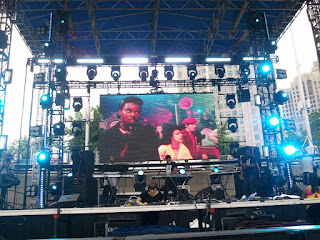I say very hard because the whole book is a detailed description of a space program that could have been real. Stephen Baxter is an engineer by training and many NASA engineers and astronauts were involved in creating 'Voyage'. The story does have human eyes and many of the events are seen through the first female (American) astronaut Natalie York, a civilian scientist who gets chosen to the crew of the first manned Mars mission. A lot of the narrative, however, is actually description about the technical and political aspects of the endeavor. This is, somewhat naturally, the strongest point of the book, and at the same time, the most boring for those who do not care about space technology and manned space flight.
The narrative switches between York's experiences aboard the Ares flight to Mars and her and others' journey through the aftermath of Apollo, astronaut training, NASA internal politics, flight hardware contracting process and, quite importantly, the development of the NERVA nuclear booster stage. We meet York's boyfriend, a couple of fictional astronauts, the fatherly veteran cosmonaut, many NASA administrators and directors. Everything is connected and Natalie York's sometimes cynical attitude reflects the realities of manned space program.
Indeed, York is chosen for astronaut training as one of the new scientist astronauts, to complement the old test-pilot astronauts, who she regards as 'assholes' with a macho attitude. To get freedom handling his characters, Baxter embeds fictional astronauts in the history of spaceflight - Joe Muldoon seems to be a fusion of Deke Slayton and Buzz Aldrin and is described as having been the LM pilot of Apollo 11 and is in the focus as a new director of NASA - and does have many of Aldrin's personality traits. Chuck Jones is a former Mercury astronaut, an archetype of a flight jock, a manly test pilot who perishes with his crew during the Apollo-N test flight. He reminds me of Alan Shepard. The Soviet veteran cosmonaut Vladimir Viktorenko is, of course, the fictional counterpart of Alexei Leonov, even so far as being the commander of the Soyuz/Moonlab mission (counterpart of Apollo Soyuz Test Project), where he meets Joe Muldoon (commander of Moonlab, clearly a counterpart of Deke Slayton in this role).
In the story, Apollo 13 happens as in real history but then President Richard Nixon cancels all future Apollo missions, except for Apollo 14, which is a huge success. After a lot of speculation of the future of the American space program and plans of a Space Shuttle (and launching of two "wet workshop" space stations), Nixon authorizes the manned Mars program, named Ares. It is to employ the NERVA nuclear engine as the third stage of the successful Saturn V booster. However, its first manned test flight goes wrong as the NERVA stage blows up (due to damage after S-I stage pogo oscillates during launch) and the astronauts die of radiation exposure. After this disaster, the NERVA project is cancelled and a Venus flyby trajectory is chosen, with S-II (with extra fuel tanks) acting as injection booster.
The development of the Mars Excursion Module (MEM) by (fictional) Columbia Aerospace and its innovative but obsessive director JK Lee gets a lot of attention in the story. It is a classic tale of heroic engineers - an echo of the Apollo program of the 1960's. Baxter in no way pretends that the engineering work that went into Apollo and in this book to Ares was the right way to work - he makes it very clear how working around the clock does bad things to marriages, physical and mental health and so on. The obstacles of getting the program funded by the Senate are detailed, too.
An excellent YouTube video of the Ares mission as depicted in the book
This is an engineering adventure. All the characters in this novel live for the program. Through them, the reader experiences the process of building a manned space program.
Some details did not completely fit in place. I may be nitpicking, but there is no reference to the actual flight numers of the Ares program. There is only one manned Mars mission - called Ares - but the several test flights are only referred with the mission types, not mission names. Or should I expect a flight to be called "Ares D-prime"? The NERVA test flight was called Apollo-N for some reason. A more logical naming would have been Ares 1 for the first test flight of the program, Apollo-N being maybe Ares 4. The manned Mars flight might have been Ares 12.
The descriptions of Skylab/Moonlab, Saturn VB, mission control and other aspects of (fictional) manned spaceflights are very realistic and vivid. They reflect very much what flying to space is like - or how I would imagine it to be. There are many anecdotes of obsolete technology, fears of disasters and failures and endless notions of the test pilot astronauts' not-so-perfect attitudes towards serious scientific work.
The novel is quite balanced, straight-forward engineering adventure. The reader must withstand tons of technobabble but is also rewarded after going through it all. Everyone interested in manned spaceflight should read this book - not because of the quality of its narrative (which is not bad) but because of the unique and believable vision of how humans would have reached Mars.


